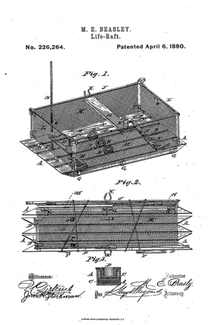Maria E. Beasley
Born in North Carolina, Beasley grew up with a strong interest in mechanical work and learned about the profession of barrel-making from her grandfather.
Between 1878 and 1898, she patented fifteen inventions in the United States: these included a footwarmer, an improved life raft, and an anti-derailment device for trains; however, her primary success as an inventor rose from a specialty in barrel-making machines and processes.
Maria showed a keen interest in mechanics as a youth, and spent time familiarizing herself with her father's mill machinery and grandfather's distillery.
Beasley then decided there would be better educational opportunities for their sons further north, so she sold the land in Kentucky and moved the family again, this time to Philadelphia, Pennsylvania.
She visited different barrel-making businesses around the country to assess manufacturing procedures and concluded that the most difficult step was the task of placing hoops around the barrel staves.
[16] Beasley's innovations were exhibited at the World's Columbian Exposition in 1893, and her family was staunchly supporting her work: John Q. had become a patent agent to help market her designs, while their son Walter managed operations in her factory.
[4] Historian B. Zarina Khan notes that despite the laws of coverture (which gave men legal rights over their wives' earnings and possessions), John Q. explicitly signed away any claims he might have held over his wife's business transactions, consequently ensuring that her clients and partners could not abuse her legal status as a married woman to rescind on their agreements.
She believed the answer rested on improving the speed of trains through electrification, rather than relying on refrigerator cars to keep goods cool.
She built a short experimental rail line around her property and began working out ways in which a train could be redesigned to support and withstand speeds of up to 100 miles per hour.
[17] In March 1895, James G. Hulse, Parker Crittenden and John W. Hill incorporated the Inter Ocean Electric Railway company with $200 million of capital (the largest capitalized stock incorporated in the West at the time),[18] and the company announced its intention of building an elevated electric railway between New York, Chicago and San Francisco, with Beasley presented as the primary designer and motivational force behind a new and improved train.
[11] Her updated patent aims to account for differences and imperfections in the shape of barrel staves and hoops; it uses radially-adjustable arms and jaws to hold materials more firmly in place.
[21] Beasley’s raft uses a base of collapsible metal floats that is more flexible and makes storage on board a ship easier, also including airtight containers to protect perishable provisions.
The guardrail uses a strong top flange (a protruding edge or rim), located at the inner side of the track rail, which engages with a detent (a mechanical catch) connected to the train.

